
www.pacifictenders.com JULY - SEPTEMBER 2023 ISSUE 14




PT your next project here www.pacifictenders.com FIND
Published by
Adkonect PNG PO Box 1954

Port Moresby, PNG www.adkonect.com.pg
Founder Publisher
Mr. Rodney Rupokets rodney@pacifictenders.com
Business and Marketing Director

Ms. Namoi Kaluae
Editor
Mr. Douglas Saefoa (Solomon Islands)
Contributing Writers


Mr. David Spring (Sydney, Australia)
Mr. Jason Kaut (Port Moresby, PNG)
Advertising Enquiries
contact@pacifictenders.com sorbie@pacifictenders.com
www.pacifictenders.com
S.I +677 38229
PNG +675 75971524
PNG +675 75923057
Editorial Enquiries email: media@pacifictenders.com
or PNG Contact
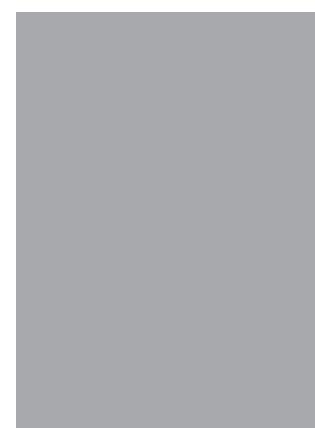
In country Marketing/Advertising
Mr. sorbie Pandiruo
Distribution PT-Magazine is distributed via a Digital Copy accessed from the pacifictenders.com Platform reaching all PT Subscriber Companies and printed copies distributed to Government Agencies, Hotels, Retail and Hardware Supermarkets in Honiara and Port Moresby. Relying on the support of our peers in the Construction and Infrastructure sectors to help this initiativ e grow.
10 LOCAL
INFRASTRUCTURE SUPPORT TO SOLOMON ISLANDS CONTENTS COVER STORY BRIDGING THE DIGITAL GAP Chinese Tech Giant Takes on Ambitious Solomon Islands National Broadband Infrastructure Project 05
Solomon
Embarks
National Broadband Project with Huawei Amidst Challenges
CONTENT KEY TO AUSTRALIA’S
07
Islands
on
13
tok
BROADBAND TOWERS FUNDED BY CHINESE LOAN: HERE COMES THE INTERNET EDITORIAL 16 THAT’S A WRAP: SIRAP2 PROJECT LAUNCHED 08 THE PACIFIC INFRASTRUCTURE CONFERENCE: yumi tok
i gud?
BRIDGING THE DIGITAL GAP
Chinese Tech Giant Takes on Ambitious Solomon Islands National Broadband Infrastructure Project
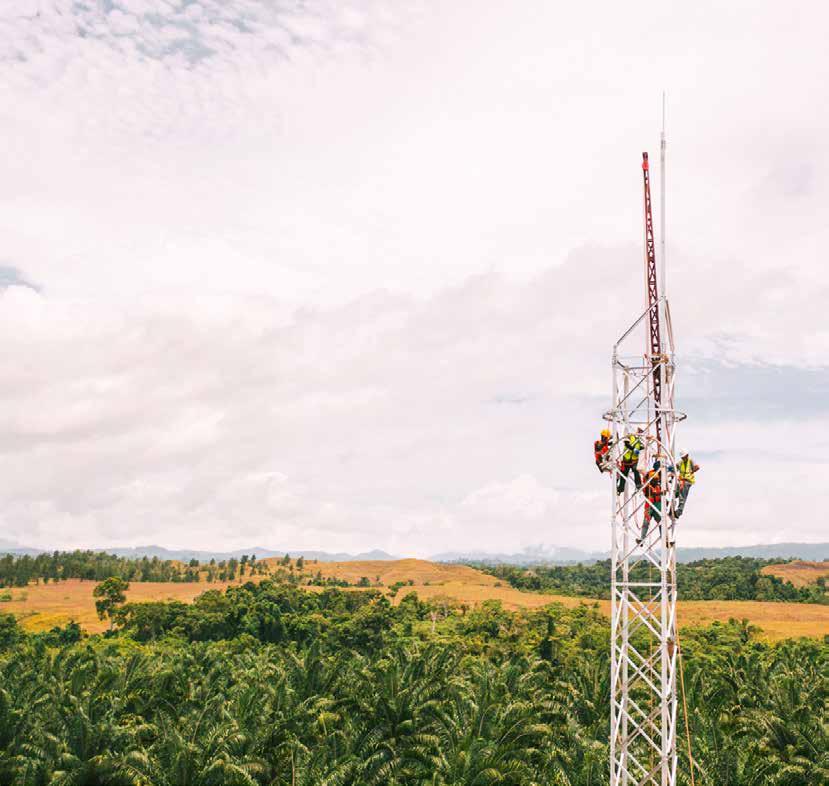
THE Solomon Island National Broadband Infrastructure Project (SINBIP) is making significant strides in advancing the nation's connectivity and accessibility, aligning with the government's commitment to bridging the digital divide. Building upon the initial phase, which saw the installation of a fiber optic submarine cable connecting Sydney to the Solomon Islands in 2020, SINBIP represents the second phase of the government's initiative to connect the unconnected in the archipelago.
The term "digital divide" underscores the gap between those with access to government services and telecommunications and those without. Those with direct access experience improved lives and opportunities, while those without lag behind. In the field of telecommunications, the Ministry of Communication and Aviation, representing the government,
aims to facilitate broadband access for all residents of the Solomon Islands.
According to the Director for Communications within the Ministry of Communication and Aviation Mr. Alvin Danitofea, currently, Internet access in the Solomon Islands stands at just over 20%. However, SINBIP is set to change this landscape dramatically. With the deployment of 161 strategically located towers across the islands, the government anticipates boosting broadband and Internet coverage to more than 80%. The placement of these towers is carefully planned, with collaboration between the government and Solomon Telekom to identify areas in need of connectivity.
Notably, the government is avoiding duplicating coverage areas already served by cellular networks, instead focusing on areas with significant gaps in service provision. A government
INFRASTRUCTURE DEVELOPMENT / INDUSTRY
> www.pacifictenders.com 5 COVER STORY
The first pilot site of the SINBIP project at Central Guadalcanal.
survey identified the need for 161 towers to fill these gaps, representing a substantial 60% increase from the current coverage.
The project will begin its rollout from Shortland Islands in the west to the easternmost block of Temotu Province. It will extend from Sikiana in the north to Rennell and Bellona Provinces in the south, covering the entire Solomon Islands archipelago.
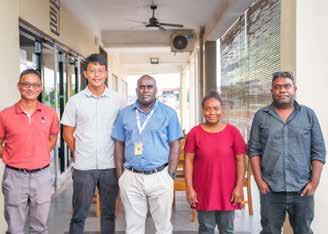

The project, which recently commenced with the construction of towers in Guadalcanal, is scheduled to take three years for completion. Funding for SINBIP is secured through a concession loan from the People's Republic of China at a minimal 1% interest rate. The government has contracted Huawei for the provision of radio equipment, while China Harbour Engineering Company (CHEC), an infrastructure specialist, is tasked with tower construction.
A crucial aspect of the project is the ownership structure of the infrastructure. The towers will ultimately be owned by Solomon Island Tower Company, a company already established for this purpose. Huawei will install the radio equipment and microwave systems, and in partnership with Solomon Telekom, they will manage the tower network. Importantly, all communication through these towers will be routed back to Telekom's core network and distributed to service providers, allowing multiple operators to utilize the infrastructure.
The benefits of SINBIP extend beyond improved connectivity. The government's national ICT policy, national E-commerce strategy, and national financial inclusion strategy all aim to enhance access to government services, online businesses, and financial services. Government ministries are collaborating to provide e-commerce platforms and support online services.
Furthermore, the Ministry of Communication and Aviation
is working to develop a national e-government strategy with support from the United Nations Development Programme (UNDP). Additionally, the Ministry of Education continues to implement the national ICT for Education master plan. All of these initiatives are contingent upon the successful implementation of SINBIP, underlining the government's commitment to expanding internet accessibility.
The Solomon Island National Broadband Infrastructure Project represents a critical milestone in the nation's journey toward digital transformation. It not only bridges the digital divide but also paves the way for a future where commercial, educational, and government services are readily accessible online. The project's significance lies not only in the infrastructure it builds but also in the broader digital ecosystem it supports, positioning the Solomon Islands for a prosperous digital age. l
Construction workers at the first pilot site of the SINBIP project at Central Guadalcanal.
www.pacifictenders.com < JULY - SEPTEMBER 2023 / ISSUE 14 6
The SINBIP project team.
Solomon Islands Embarks on National Broadband
Project with Huawei Amidst Challenges
In a bid to enhance the nation's digital connectivity, the Solomon Islands has taken a significant step forward with the launch of the Solomon Islands National Broadband Infrastructure Project (SINBIP), set to deploy up to 161 cellular towers across the country.
THIS ambitious endeavor is a collaborative effort involving Chinese tech giant Huawei and China Harbour Engineering Company (CHEC), with the project being funded by a concessional loan from the Exim Bank of China amounting to approximately CNY 448.9 million (equivalent to around A$95.5 million).

The agreement for this transformative project was officially announced on August 18, 2022, marking a historical financial partnership between the Solomon Islands and the People's Republic of China (PRC). The project holds particular significance as it strengthens the diplomatic ties established between the two nations in 2019.
The Solomon Islands government has expressed its enthusiasm for the project, emphasizing that an independent review of SINBIP has confirmed its financial viability. The review indicated that the project would generate substantial revenues, enabling the government to repay both the principal loan amount and interest costs within the loan period.
To oversee the infrastructure, a new government-owned company will be established. The network is designed to integrate with the existing core of Solomon Telekom Company Limited (STCL), although a memorandum of understanding (MoU) outlining this arrangement is still pending.
Despite initial optimism, the project has faced challenges that have led to delays in its implementation. According to Secretary to the Prime Minister, Dr. Jimmie Rodgers, the inability of Solomon Telekom to promptly decide on partnering with the government for tower delivery and operations has contributed to the delay. Additionally, the Ministry of Communication and Aviation's struggles to secure funds for technical survey teams
and the time-consuming planning process for the Development Budget in 2023 have further impeded progress.
The goal of SINBIP is to ensure improved internet and mobile connectivity across the Solomon Islands, benefitting both urban and rural communities. The project is planned to roll out from Guadalcanal to Central and Isabel Provinces. Prime Minister Manasseh Sogavare expressed his optimism during the groundbreaking ceremony on 1 August 2023, stating that the project aligns with the Democratic Coalition Government for Advancement's policy of constructing transformative infrastructures.
Originally, the government aimed to have 48 percent of the 161 towers installed by November, coinciding with the Pacific Games. However, due to the aforementioned challenges, the construction progress is now projected to reach only around 20 percent by that time.
The SINBIP not only aligns with the government's policy goals but also resonates with the Solomon Islands National Infrastructure Investment Plan (2013), National ICT Policy (2015), and Solomon Islands National Development Strategy, 2016-2035 (2016). The project's funding, a 20-year concessional loan from the Exim Bank of China at a low one percent interest rate, underscores China's commitment to supporting the Solomon Islands' technological advancement.
As the Solomon Islands navigate challenges and work to overcome obstacles, the SINBIP remains a symbol of the country's determination to embrace digital transformation and bridge connectivity gaps, ultimately propelling the nation towards a more digitally inclusive future. l
INFRASTRUCTURE DEVELOPMENT / INDUSTRY > www.pacifictenders.com 7
Centre L-R: PRC Ambassador H.E.Li Ming, PM Sogavare and Minister for Communication and Aviation, Peter Shanel at the official ground breaking ceremony.
The Pacific Infrastructure Conference:
DAVID SPRING PT COLUMNIST Sydney, Australia

TAKING a stroll down Honiara’s Mendana Avenue, it doesn’t take an engineer to see the infrastructure needs. Congestion in two directions, port traffic at a stand-still, dysfunctional intersections, potholes in the road, inadequate drainage, haphazard footpaths. While Mendana Avenue is one of the lucky ones, with a project underway to upgrade it, there are plenty of other pressing infrastructure needs across the Pacific which remain unaddressed. The Australia-Pacific Islands Business Council is holding a conference in September which it hopes will take the next step towards addressing them. “Developing Sustainable Resilient Infrastructure in the Blue Pacific” is aimed at ‘urgent needs’ and how resilient infrastructure can combat climate change and mitigate its effects.
The term ‘Blue Pacific’ came to prominence in 2019 when deployed by the Pacific Islands Forum to describe the collective interests of Pacific countries and the regionalism that will help to further those interests. This Blue Pacific Continent concept resonated widely and has been appropriated for this conference. This is not undue – two other prominent business councils, Fiji and Papua New Guinea are co-hosting the conference and each PIF country will be represented.
attending. Its claim to a diverse range of speakers is authentic –industry, Pacific governments, bilateral government partners, interest groups and a gaggle of specialists. This provides delegates with a variety of perspectives, interests and common concerns, as well as valuable vassals for networking and promotion.
The second day of the conference comprises breakout sessions, featuring a project, an issue and a pipeline overview for each country. This is an important opportunity to concentrate on the specific needs and opportunities at a local level.
The ambitious agenda aims to tackle some subjects dear to the heart of the conference sponsors – women in construction, multilateral bank priorities, effective standards, procurement processes, governments providing business with enabling environments.
Never waste a good crisis
The conference may not be billed as such, but there is some cause for celebration in the volume of infrastructure planned and delivered over the past few years. Despite the travails of COVID-19, most countries have recovered well and anticipate economic growth in 2023 and 2024.
The Conference has much to recommend it. High level representatives from Pacific and donor countries alike are
Due to the long lead times on infrastructure projects, immediate expenditure on new roads and wharves to drive the construction industry was not an option for most countries. Solomon Islands was unique in that there were already several projects planned
“A meeting of two or more persons to discuss matters of common concern”
www.pacifictenders.com < JULY - SEPTEMBER 2023 / ISSUE 14 8
yumi tok tok i gud?
and underway to deliver infrastructure ahead of the Pacific Games in November 2023. Broadly, most of the focus was on the recovery of tourism and exports, but infrastructure and connectivity underpins this growth.
This is good news for conference delegates – pent up demand for economic infrastructure will result in financing for projects, which have already begun flowing to the market. Beyond the Pacific Games, SIRAP2 (World Bank) and SIIP (Australia) will deliver road upgrades, bridges and ports across the country. The Japanese and ADB are upgrading different parts of the main highway in Honiara. PNG remains a powerhouse. After 9 years of low growth, supported almost entirely by the resources sector, both macroeconomic structures and civil infrastructure are up for renewal. Renewable energy, major port upgrades, ambitious road projects and large ongoing investments to road upgrade and maintenance are all planned. The resources sector continues to grow, with a $12bn investment in the Papua LNG plant set to start in 2024.
In Tonga, the additional financing for the Nuku’alofa port upgrade will cover cost overruns of almost double the estimate, enabling construction to continue. The largescale Fanga’uta Lagoon bridge project continues its march to the market, with construction tenders closing earlier this year and a scheduled to start in 2024.
Gift of the gab
The concern with this (as most) conferences is that they are primarily a talk fest, with a scatter gun of issues to ‘focus’ on. Is that fair?
It is interesting that despite the title and promotion of the conference being about climate change, there are no specific presentations or breakout sessions on climate change, resilience or sustainability. Resilience and mitigation is often used as a convenient substitute for talking about the actual causes of climate change, and the conference appears silent on Australia’s masquerade on emissions reduction, for example. Perhaps these issues will be tackled in the keynote speeches, pipeline analyses or case studies.
In the current geopolitical climate, it is understandable that China is the elephant in the room. However, given China’s presence in the region, it remains unfortunate that they are not in attendance, either by design or choice. It will be hard to have a holistic discussion of the development of sustainable resilient infrastructure without including dialogue on China’s contribution to both infrastructure and climate change. Indeed, it is geostrategic competition with China that is driving much of the current infrastructure spending. The neo-colonial overtones are hard to avoid. Donors still like to be known as donors, regardless of their loans’ contributions to recipient’s deepening vulnerability.
In the current geopolitical climate, it is understandable that China is the elephant in the room. However, given China’s presence in the region, it remains unfortunate that they are not in attendance, either by design or choice. It will be hard to have a holistic discussion of the development of sustainable resilient infrastructure without including dialogue on China’s contribution to both infrastructure and climate change. Indeed, it is geostrategic competition with China that is driving much of the current infrastructure spending.
Resilient relationships
There is no doubt that there is value in the relational side of a conference such as this. Discussions over coffee and a blueberry danish, or sharing a table at dinner is great for network building. The infrastructure industry in the Pacific has about 1 degree of separation, so the camaraderie is real. Businesses can use the opportunity to form relationships and partnerships which may or may not pay off in a business sense, but will deepen connections. These are not the sort of ‘urgent needs’ that the organisers had in mind when they wrote the conference promotion. But as climate change makes its impact, perhaps resilient relationships will prove more valuable that any sea wall or bridge. Though dusty, is it really Mendana Avenue that needs the upgrade? l
About the Author
David is an experienced engineer, with over 20 years experience in construction, design and international development. David has been working in Solomon Islands and Vanuatu as a team leader for the past six years, specifically on road and bridgeworks. He worked on intraMinistry roles at the Ministry of infrastructure Development (MID, Solomon Islands) and led the Cyclone Pam road reconstruction project in Vanuatu, understanding donor requirements and how development projects are procured and delivered. Continuing as a Team leader for MID and with some corporate responsibilities for Cardno, David seeks to deliver equitable access for communities, which generate social and economic benefits.
INFRASTRUCTURE DEVELOPMENT / INDUSTRY > www.pacifictenders.com 9
LOCAL CONTENT KEY TO AUSTRALIA’S INFRASTRUCTURE SUPPORT TO SOLOMON ISLANDS

Seizing opportunities to grow Solomon Islands’ local construction industry
WHEN Solomon Islands’ mother of two, Priscilla Fakai’a, saw an advertisement for women to complete a Certificate II course in Construction, she jumped at it.
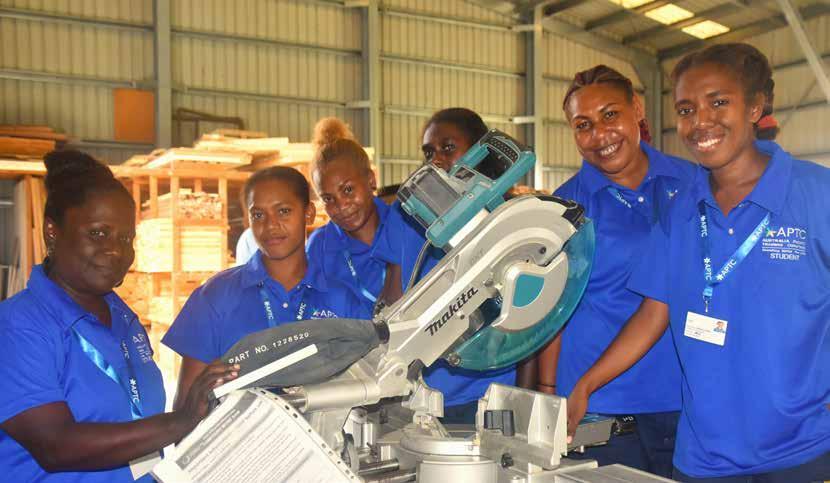
‘When I saw the Green Construction Program for women, I said to myself – this is the course for me. Construction has always been seen as men’s work, but I believe that women can also excel in the industry.’
Since 2019, Australia has committed over SBD $5 billion in inclusive and community-minded infrastructure across Solomon Islands. And of the 12,759 jobs Australia has created for Solomon Islanders since 2021, 4,286 have been through infrastructure. With Solomon Islanders like Priscilla at the forefront, the infrastructure partnership is seizing opportunities to grow the capacity of Solomon Islands’ local construction industry and deliver lasting, tangible benefits to communities across the country.
An emphasis on locally led infrastructure is seeing more of Australia’s development funding being spent in Solomon Islands, bringing a wide range of local economic benefits. In support of increased prosperity, Australia is funding the construction or redevelopment of seven markets across the country to help drive money-making opportunities for rural communities. The markets are being designed based on the success of a local content approach taken in 2019 to redevelop Gizo Market in Western Province. During this project, building design and material selection considered how infrastructure could be built locally, with materials procured locally, and maintained locally after handover.
Australia’s Community Partnership grants deliver smaller scale but critical infrastructure to communities, for communities. Projects include water tanks, ablution blocks, solar lighting for health clinics, classroom buildings and community halls. These smaller scale projects impact positively upon the health and sustainability
www.pacifictenders.com < 10
Pricilla Fakai'a (far left) and fellow cohorts who are being supported by SIIP and APTC to participate in a six-month Certificate II in Construction Course.
CURRENT PROJECTS
CURRENT PROJECTS
CURRENT PROJECTS
and Bridges, Malaita Province
FOR EACH PROJECT
Lata Bio-medical Lab, Temotu Province Naha Birthing and Urban Health Centre, Honiara Gizo Water Supply Project, Western Province Honiara Central
FOR EACH PROJECT
, Central Province Buala, Isabel Province Malu’u, Malaita Province
Seghe, Western Province
, Guadalcanal Province
















FOR EACH PROJECT
FOR EACH PROJECT
START AND END DATES FOR EACH PROJECT
START AND END DATES FOR EACH PROJECT
of rural communities.
Ahead of the 2023 Pacific Games, Australia is handing over facilities including the Iumi
FOR EACH PROJECT
Water Sports Park and newly refurbished buildings as part of its school dormitory and classroom upgrade project across seven schools. While the refurbished school buildings will support successful delivery of the Pacific Games by housing athletes from across the Pacific family, they will also have a lasting impact on the learning and development of students beyond the life of the Pacific Games.
These locally led approaches require upskilling support to Solomon Islands’ construction industry. Australia’s Solomon Islands Infrastructure Partnership (SIIP) Workforce Skills Series’ industry training program engages local contractors and suppliers across a range of topics, from occupational health and safety, local content planning and environmental regulations.
The training program has seen tangible outcomes. For example, training on gender equality, disability and social inclusion has resulted in a local company recruiting a female engineer into their team. A local firm also won the contract to deliver early works on the Australian-funded Naha Birthing and Urban Health Centre in Honiara. As part of SIIP’s requirement for local content industry participation plans, the same firm also recruited two construction graduates from the Solomon Islands National University. In other examples, local firms have partnered with international firms to jointly tender for projects.
Australia’s High Commissioner to Solomon Islands, Rod Hilton says ultimately, such locally led development approaches deliver better outcomes for Solomon Islanders, with Australian funding leading to the creation of more local jobs in Solomon Islands and
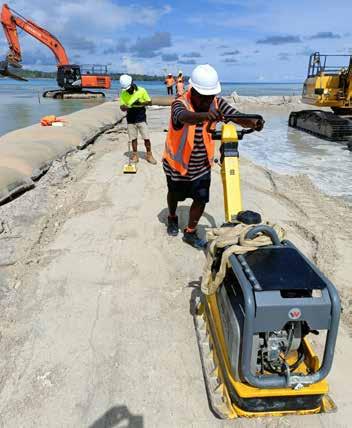
FOR MORE INFORMATION VISIT siip.com.sb 2024 2025 2026 D J M A M J J A S J F M A M J J A S O N D J F M Redevelopment Design Wharf Bridges Redeveopment Redevelopment Redevelopment Extn Mendana Highway Redevelopment Tenaru Market Redevelopment Honiara Fish Market Redevelopment Kirakira Market Redevelopment
CURRENT PROJECTS
Design Moli Wharf SBD 28.8m Buala Wharf SBD 33.4m Fiu Bridge SBD 86.4m Auki–Bina Road SBD 63.4m Malu’u Market Redevelopment SBD 20.7m Redevelopment Tenaru Market Redevelopment SBD 0.7m Buala Market Redevelopment $20.7m Tulagi Market Redevelopment SBD 0.6m Temotu BioMed Lab SBD 1.3m Kirakira Market Redevelopment SBD 12.1m Honiara Central Market Extension SBD 5.8m Honiara Fish Market Redevelopment SBD 5.8m Naha BUHC SBD 149.8m Bus Shelters SBD 2.9m Pedestrian Overpass, Mendana Highway SBD 0.6m Bina Harbour Water Supply and Sanitation Project SBD 1.1m ISABEL MALAITA GUADALCANAL MAKIRA TEMOTU Honiara CENTRAL TRANSPORT SBD 490.74m CURRENT PROJECTS FOR MORE INFORMATION VISIT siip.com.sb 2024 2025 2026 S O N D J F M A M J J A S O N D J F M A M J J A S O N D J F M Redevelopment Design Moli Wharf Buala Wharf Auki–Bina Road & Bridges Redeveopment Redevelopment Bio-Med Lab Redevelopment Central Market Extn Overpass, Mendana Highway Market Redevelopment Tenaru Market Redevelopment Honiara Fish Market Redevelopment Kirakira Market Redevelopment
Redevelopment Design Moli Wharf SBD 28.8m Buala Wharf SBD 33.4m Fiu Bridge SBD 86.4m Auki–Bina Road SBD 63.4m Malu’u Market Redevelopment SBD 20.7m Redevelopment Upgrade Tenaru Market Redevelopment SBD 0.7m Upgrade Supply Project Buala Market Redevelopment $20.7m Tulagi Market Redevelopment SBD 0.6m Temotu BioMed Lab SBD 1.3m Kirakira Market Redevelopment SBD 12.1m Honiara Central Market Extension SBD 5.8m Honiara Fish Market Redevelopment SBD 5.8m Naha BUHC SBD 149.8m Bus Shelters SBD 2.9m Pedestrian Overpass, Mendana Highway SBD 0.6m Bina Harbour Water Supply and Sanitation Project SBD 1.1m ISABEL MALAITA GUADALCANAL MAKIRA TEMOTU Honiara CENTRAL TRANSPORT SBD 490.74m CURRENT PROJECTS FOR MORE INFORMATION VISIT siip.com.sb 2024 2025 2026 D J F M A M J J A S O N D J F M A M J J A S O N D J F M Redevelopment Design Wharf Bridges Redeveopment Redevelopment Redevelopment Extn Mendana Highway Redevelopment Tenaru Market Redevelopment Honiara Fish Market Redevelopment Kirakira Market Redevelopment
Design Moli Wharf SBD 28.8m Buala Wharf SBD 33.4m Fiu Bridge SBD 86.4m Auki–Bina Road SBD 63.4m Malu’u Market Redevelopment SBD 20.7m Redevelopment Tenaru Market Redevelopment SBD 0.7m Buala Market Redevelopment $20.7m Tulagi Market Redevelopment SBD 0.6m Temotu BioMed Lab SBD 1.3m Kirakira Market Redevelopment SBD 12.1m Honiara Central Market Extension SBD 5.8m Honiara Fish Market Redevelopment SBD 5.8m Naha BUHC SBD 149.8m Bus Shelters SBD 2.9m Pedestrian Overpass, Mendana Highway SBD 0.6m Bina Harbour Water Supply and Sanitation Project SBD 1.1m ISABEL MALAITA GUADALCANAL MAKIRA TEMOTU Honiara CENTRAL TRANSPORT SBD 490.74m Honiara
Shelters
Airfield Upgrade
Province Seghe Airfield Upgrade
Province
Noro
Tulagi
Seghe
Tenaru
Kirakira
Makira Province
DATES FOR EACH PROJECT
Bus
Taro
, Choiseul
, Western
Buala Wharf, Isabel Province
Port Detailed Design, Western Province Roads and Bridges, Malaita Province Lata Bio-medical Lab, Temotu Province Naha Birthing and Urban Health Centre, Honiara Gizo Water Supply Project, Western Province Honiara Central
, Central Province Buala, Isabel Province Malu’u, Malaita Province
, Western Province
, Guadalcanal Province
,
FOR MORE INFORMATION VISIT siip.com.sb 2024 2025 2026 D J M A M J J A S O N D J F M A M J J A S O N D J F M Redevelopment Design Wharf Bridges Redeveopment Redevelopment Redevelopment Extn Mendana Highway Redevelopment Tenaru Market Redevelopment Honiara Fish Market Redevelopment Kirakira Market Redevelopment
Design Moli Wharf 28.8m Buala Wharf SBD 33.4m Fiu Bridge SBD 86.4m Auki–Bina Road SBD 63.4m Malu’u Market Redevelopment SBD Redevelopment Tenaru Market Redevelopment SBD 0.7m Buala Market Redevelopment $20.7m Tulagi Market Redevelopment SBD 0.6m Temotu BioMed Lab SBD 1.3m Kirakira Market Redevelopment SBD 12.1m Honiara Central Market Extension SBD 5.8m Honiara Fish Market Redevelopment SBD 5.8m Naha BUHC SBD 149.8m Bus Shelters SBD 2.9m Pedestrian Overpass, Mendana Highway SBD 0.6m Bina Harbour Water Supply and Sanitation Project SBD 1.1m ISABEL MALAITA GUADALCANAL MAKIRA TEMOTU Honiara CENTRAL TRANSPORT SBD 490.74m CURRENT PROJECTS FOR MORE INFORMATION VISIT siip.com.sb 2022 2023 2024 2025 2026 O N D J F M A M J J A S O N D J F M A M J J A S O N D J F M A M J J A S O N D J F M Noro Port Redevelopment Design Moli Wharf Buala Wharf Fiu Bridge Auki–Bina Road & Bridges Buala Market Redeveopment Malu’u Market Redevelopment Temotu Bio-Med Lab Water Supply Project Taro Airport Upgrade Naha BUHC Seghe Airport Upgrade Tulagi Market Redevelopment Honiara Central Market Extn Bus Shelters Pedestrian Overpass, Mendana Highway Harbour Water Supply and Sanitation Project Seghe Market Redevelopment Tenaru Market Redevelopment Honiara Fish Market Redevelopment Kirakira Market Redevelopment
Noro Port Redevelopment Design SBD 8.64m Moli Wharf SBD 28.8m Buala Wharf SBD 33.4m Fiu Bridge SBD 86.4m Auki–Bina Road SBD 63.4m Malu’u Market Redevelopment SBD 20.7m Seghe Market Redevelopment SBD 20.7m Taro Airport Upgrade $133.3m Tenaru Market Redevelopment SBD 0.7m Seghe Airport Upgrade SBD 133.3m Gizo Water Supply Project SBD 57.6m Buala Market Redevelopment $20.7m Tulagi Market Redevelopment SBD 0.6m Temotu BioMed Lab SBD 1.3m Kirakira Market Redevelopment SBD 12.1m Honiara Central Market Extension SBD 5.8m Honiara Fish Market Redevelopment SBD 5.8m Naha BUHC SBD 149.8m Bus Shelters SBD 2.9m Pedestrian Overpass, Mendana Highway SBD 0.6m Bina Harbour Water Supply and Sanitation Project SBD 1.1m CHOISEUL ISABEL MALAITA WESTERN GUADALCANAL MAKIRA TEMOTU Honiara CENTRAL TRANSPORT SBD 490.74m MARKETS 103.1m HEALTH 1.1m ECONOMIC INFRASTRUCTURE SBD 58.7m TOTAL INFRASTRUCTURE INVESTMENT 803.64m CURRENT PROJECTS FOR MORE INFORMATION VISIT siip.com.sb 2023 2024 2025 2026 J F M A M J J A S O N D J F M A M J J A S O N D J F M A M J J A S O N D J F M Noro Port Redevelopment Design Moli Wharf Buala Wharf Fiu Bridge Auki–Bina Road & Bridges Buala Market Redeveopment Malu’u Market Redevelopment Temotu Bio-Med Lab Water Supply Project Taro Airport Upgrade Naha BUHC Seghe Airport Upgrade Tulagi Market Redevelopment Honiara Central Market Extn Bus Shelters Pedestrian Overpass, Mendana Highway Harbour Water Supply and Sanitation Project Seghe Market Redevelopment Tenaru Market Redevelopment Honiara Fish Market Redevelopment Kirakira Market Redevelopment START AND END DATES FOR EACH PROJECT Noro Port Redevelopment Design SBD 8.64m Moli Wharf SBD 28.8m Buala Wharf SBD 33.4m Fiu Bridge SBD 86.4m Auki–Bina Road SBD 63.4m Malu’u Market Redevelopment SBD 20.7m Seghe Market Redevelopment SBD 20.7m Taro Airport Upgrade $133.3m Tenaru Market Redevelopment SBD 0.7m Seghe Airport Upgrade SBD 133.3m Gizo Water Supply Project SBD 57.6m Buala Market Redevelopment $20.7m Tulagi Market Redevelopment SBD 0.6m Temotu BioMed Lab SBD 1.3m Kirakira Market Redevelopment SBD 12.1m Honiara Central Market Extension SBD 5.8m Honiara Fish Market Redevelopment SBD 5.8m Naha BUHC SBD 149.8m Bus Shelters SBD 2.9m Pedestrian Overpass, Mendana Highway SBD 0.6m Bina Harbour Water Supply and Sanitation Project SBD 1.1m CHOISEUL ISABEL MALAITA WESTERN GUADALCANAL MAKIRA TEMOTU Honiara CENTRAL TRANSPORT SBD 490.74m MARKETS 103.1m HEALTH 1.1m ECONOMIC INFRASTRUCTURE SBD 58.7m TOTAL INFRASTRUCTURE INVESTMENT 803.64m 2024 2025 2026 D J A M J J A S O N D J F M A M J J A S O N D J F M Redevelopment Design Wharf Bridges Redeveopment Redevelopment Redevelopment Extn Mendana Highway Redevelopment Tenaru Market Redevelopment Honiara Fish Market Redevelopment Kirakira Market Redevelopment
Design Moli Wharf SBD 28.8m Buala Wharf SBD 33.4m Fiu Bridge SBD 86.4m Auki–Bina Road SBD 63.4m Malu’u Market Redevelopment SBD 20.7m Redevelopment Tenaru Market Redevelopment SBD 0.7m Buala Market Redevelopment $20.7m Tulagi Market Redevelopment SBD 0.6m Temotu BioMed Lab SBD 1.3m Kirakira Market Redevelopment SBD 12.1m Honiara Central Market Extension SBD 5.8m Honiara Fish Market Redevelopment SBD 5.8m Naha BUHC 149.8m Bus Shelters Pedestrian Overpass, Mendana Highway Bina Harbour Water Supply and Sanitation Project SBD 1.1m ISABEL MALAITA GUADALCANAL MAKIRA TEMOTU Honiara CENTRAL TRANSPORT SBD 490.74m Transport and Connectivity CURRENT PROJECTS Essential Services Markets Solomon Islands Infrastructure Program Pipeline Taro Airfield Buala Wharf and Market Noro Port Gizo Water Tenaru Market Lata Bio-medical Lab Seghe Market and Airfield Tulagi Market Honiara Bus Shelters Honiara Central Market Naha Birthing and Urban Health Centre Malu’u Market Malaita roads and bridges Kirakira Market CURRENT PROJECTS FOR MORE INFORMATION VISIT siip.com.sb 2024 2025 2026 D J M A M J J A S O N D J F M A M J J A S O N D J F M Redevelopment Design Wharf Bridges Redeveopment Redevelopment Redevelopment Extn Mendana Highway Redevelopment Tenaru Market Redevelopment Honiara Fish Market Redevelopment Kirakira Market Redevelopment FOR EACH PROJECT Design Moli Wharf SBD 28.8m Buala Wharf SBD 33.4m Fiu Bridge SBD 86.4m Auki–Bina Road SBD 63.4m Malu’u Market Redevelopment SBD 20.7m Redevelopment Tenaru Market Redevelopment SBD 0.7m Buala Market Redevelopment $20.7m Tulagi Market Redevelopment SBD 0.6m Temotu BioMed Lab SBD 1.3m Kirakira Market Redevelopment SBD 12.1m Honiara Central Market Extension SBD 5.8m Honiara Fish Market Redevelopment SBD 5.8m Naha BUHC SBD 149.8m Bus Shelters SBD 2.9m Pedestrian Overpass, Mendana Highway SBD 0.6m Bina Harbour Water Supply and Sanitation Project SBD 1.1m ISABEL MALAITA GUADALCANAL MAKIRA TEMOTU Honiara CENTRAL TRANSPORT SBD 490.74m CURRENT PROJECTS FOR MORE INFORMATION VISIT siip.com.sb 2024 2025 2026 S O N D J F M A M J J A S O N D J F M A M J J A S O N D J F M Redevelopment Design Moli Wharf Buala Wharf Auki–Bina Road & Bridges Redeveopment Redevelopment Bio-Med Lab Redevelopment Central Market Extn Overpass, Mendana Highway Market Redevelopment Tenaru Market Redevelopment Honiara Fish Market Redevelopment Kirakira Market Redevelopment
Redevelopment Design Moli Wharf SBD 28.8m Buala Wharf SBD 33.4m Fiu Bridge SBD 86.4m Auki–Bina Road SBD 63.4m Malu’u Market Redevelopment SBD 20.7m Redevelopment Upgrade Tenaru Market Redevelopment SBD 0.7m Upgrade Supply Project Buala Market Redevelopment $20.7m Tulagi Market Redevelopment SBD 0.6m Temotu BioMed Lab SBD 1.3m Kirakira Market Redevelopment SBD 12.1m Honiara Central Market Extension SBD 5.8m Honiara Fish Market Redevelopment SBD 5.8m Naha BUHC SBD 149.8m Bus Shelters SBD 2.9m Pedestrian Overpass, Mendana Highway SBD 0.6m Bina Harbour Water Supply and Sanitation Project SBD 1.1m ISABEL MALAITA GUADALCANAL MAKIRA TEMOTU Honiara CENTRAL TRANSPORT SBD 490.74m CURRENT
FOR MORE INFORMATION VISIT siip.com.sb 2024 2025 2026 D J F M A M J J A S O N D J F M A M J J A S O N D J F M Redevelopment Design Wharf Bridges Redeveopment Redevelopment Redevelopment Extn Mendana Highway Redevelopment Tenaru Market Redevelopment Honiara Fish Market Redevelopment Kirakira Market Redevelopment
Design Moli Wharf SBD 28.8m Buala Wharf SBD 33.4m Fiu Bridge SBD 86.4m Auki–Bina Road SBD 63.4m Malu’u Market Redevelopment SBD 20.7m Redevelopment Tenaru Market Redevelopment SBD 0.7m Buala Market Redevelopment $20.7m Tulagi Market Redevelopment SBD 0.6m Temotu BioMed Lab SBD 1.3m Kirakira Market Redevelopment SBD 12.1m Honiara Central Market Extension SBD 5.8m Honiara Fish Market Redevelopment SBD 5.8m Naha BUHC SBD 149.8m Bus Shelters SBD 2.9m Pedestrian Overpass, Mendana Highway SBD 0.6m Bina Harbour Water Supply and Sanitation Project SBD 1.1m ISABEL MALAITA GUADALCANAL MAKIRA TEMOTU Honiara CENTRAL TRANSPORT SBD 490.74m Honiara
Shelters Taro
Province Seghe
Roads
DATES FOR EACH PROJECT
PROJECTS
FOR EACH PROJECT
Bus
Airfield Upgrade, Choiseul
Airfield Upgrade, Western Province Buala Wharf, Isabel Province Noro Port Detailed Design, Western Province
Tulagi
Kirakira
Tenaru
, Makira Province
FOR MORE INFORMATION VISIT siip.com.sb 2024 2025 2026 D J F M A M J J A S O N D J F M A M J J A S O N D J F M Redevelopment Design Wharf Bridges Redeveopment Redevelopment Redevelopment Extn Mendana Highway Redevelopment Tenaru Market Redevelopment Honiara Fish Market Redevelopment Kirakira Market Redevelopment
Design Moli Wharf 28.8m Buala Wharf SBD 33.4m Fiu Bridge SBD 86.4m Auki–Bina Road SBD 63.4m Malu’u Market Redevelopment SBD 20.7m Redevelopment Tenaru Market Redevelopment 0.7m Buala Market Redevelopment $20.7m Tulagi Market Redevelopment SBD 0.6m Temotu BioMed Lab SBD 1.3m Kirakira Market Redevelopment SBD 12.1m Honiara Central Market Extension SBD 5.8m Honiara Fish Market Redevelopment Naha BUHC SBD 149.8m Bus Shelters SBD 2.9m Pedestrian Overpass, Mendana Highway SBD 0.6m Bina Harbour Water Supply and Sanitation Project SBD 1.1m ISABEL MALAITA GUADALCANAL MAKIRA TEMOTU Honiara CENTRAL TRANSPORT SBD 490.74m CURRENT PROJECTS FOR MORE INFORMATION VISIT siip.com.sb 2022 2023 2024 2025 2026 O N D J F M A M J J A S O N D J F M A M J J A S O N D J F M A M J J A S O N D J F M Noro Port Redevelopment Design Moli Wharf Buala Wharf Fiu Bridge Auki–Bina Road & Bridges Buala Market Redeveopment Malu’u Market Redevelopment Temotu Bio-Med Lab Water Supply Project Taro Airport Upgrade Naha BUHC Seghe Airport Upgrade Tulagi Market Redevelopment Honiara Central Market Extn Bus Shelters Pedestrian Overpass, Mendana Highway Harbour Water Supply and Sanitation Project Seghe Market Redevelopment Tenaru Market Redevelopment Honiara Fish Market Redevelopment Kirakira Market Redevelopment
Noro Port Redevelopment Design SBD 8.64m Moli Wharf SBD 28.8m Buala Wharf SBD 33.4m Fiu Bridge SBD 86.4m Auki–Bina Road SBD 63.4m Malu’u Market Redevelopment SBD 20.7m Seghe Market Redevelopment SBD 20.7m Taro Airport Upgrade $133.3m Tenaru Market Redevelopment SBD 0.7m Seghe Airport Upgrade 133.3m Gizo Water Supply Project 57.6m Buala Market Redevelopment $20.7m Tulagi Market Redevelopment SBD 0.6m Temotu BioMed Lab SBD 1.3m Kirakira Market Redevelopment SBD 12.1m Honiara Central Market Extension SBD 5.8m Honiara Fish Market Redevelopment SBD 5.8m Naha BUHC SBD 149.8m Bus Shelters SBD 2.9m Pedestrian Overpass, Mendana Highway SBD 0.6m Bina Harbour Water Supply and Sanitation Project SBD 1.1m CHOISEUL ISABEL MALAITA WESTERN GUADALCANAL MAKIRA TEMOTU Honiara CENTRAL TRANSPORT SBD 490.74m MARKETS 103.1m HEALTH 1.1m ECONOMIC INFRASTRUCTURE SBD 58.7m TOTAL INFRASTRUCTURE INVESTMENT 803.64m CURRENT PROJECTS FOR MORE INFORMATION VISIT siip.com.sb 2022 2023 2024 2025 O N D J F M A M J J A S O N D J F M A M J J A S O N D J F M A M J J A S Noro Port Redevelopment Design Moli Wharf Buala Wharf Fiu Bridge Auki–Bina Road & Bridges Buala Market Redeveopment Malu’u Market Redevelopment Temotu Bio-Med Lab Water Supply Project Taro Airport Upgrade Naha BUHC Seghe Airport Upgrade Tulagi Market Redevelopment Honiara Central Market Extn Bus Shelters Pedestrian Overpass, Mendana Highway Harbour Water Supply and Sanitation Project Seghe Market Redevelopment Tenaru Market Redevelopment Honiara Fish Market Redevelopment Kirakira Market Redevelopment START AND END DATES FOR EACH PROJECT Noro Port Redevelopment Design SBD 8.64m Moli Wharf SBD 28.8m Buala Wharf SBD 33.4m Fiu Bridge SBD 86.4m Auki–Bina Road SBD 63.4m Malu’u Market Redevelopment SBD 20.7m Seghe Market Redevelopment SBD 20.7m Taro Airport Upgrade $133.3m Tenaru Market Redevelopment SBD 0.7m Seghe Airport Upgrade SBD 133.3m Gizo Water Supply Project SBD 57.6m Buala Market Redevelopment $20.7m Tulagi Market Redevelopment SBD 0.6m Temotu BioMed Lab SBD 1.3m Kirakira Market Redevelopment SBD 12.1m Honiara Central Market Extension SBD 5.8m Honiara Fish Market Redevelopment SBD 5.8m Naha BUHC SBD 149.8m Bus Shelters SBD 2.9m Pedestrian Overpass, Mendana Highway SBD 0.6m Bina Harbour Water Supply and Sanitation Project SBD 1.1m CHOISEUL ISABEL MALAITA WESTERN GUADALCANAL MAKIRA TEMOTU Honiara CENTRAL TRANSPORT SBD 490.74m MARKETS 103.1m HEALTH 1.1m ECONOMIC INFRASTRUCTURE SBD 58.7m TOTAL INFRASTRUCTURE INVESTMENT 803.64m FOR MORE INFORMATION VISIT siip.com.sb 2024 2025 2026 D J F M A M J J A S O N D J F M A M J J A S O N D J F M Redevelopment Design Wharf Bridges Redeveopment Redevelopment Redevelopment Extn Mendana Highway Redevelopment Tenaru Market Redevelopment Honiara Fish Market Redevelopment Kirakira Market Redevelopment FOR EACH PROJECT Design Moli Wharf SBD 28.8m Buala Wharf SBD 33.4m Fiu Bridge SBD 86.4m Auki–Bina Road SBD 63.4m Malu’u Market Redevelopment SBD 20.7m Redevelopment Tenaru Market Redevelopment SBD 0.7m Buala Market Redevelopment $20.7m Tulagi Market Redevelopment SBD 0.6m Temotu BioMed Lab SBD 1.3m Kirakira Market Redevelopment SBD 12.1m Honiara Central Market Extension SBD 5.8m Honiara Fish Market Redevelopment SBD 5.8m Naha BUHC 149.8m Bus Shelters SBD 2.9m Pedestrian Overpass, Mendana Highway Bina Harbour Water Supply and Sanitation Project SBD 1.1m ISABEL MALAITA GUADALCANAL MAKIRA TEMOTU Honiara CENTRAL TRANSPORT SBD 490.74m Transport and Connectivity
Essential Services Markets Solomon
Infrastructure Program Pipeline Taro Airfield Buala Wharf and Market Noro Port Gizo Water Tenaru Market Lata Bio-medical Lab Seghe Market and Airfield Tulagi Market Honiara Bus Shelters Honiara Central Market Naha Birthing and Urban Health Centre Malu’u Market Malaita roads and bridges Kirakira Market
Islands
Upgrading of Taro Airfield. > www.pacifictenders.com 11
increasing economic outcomes.
‘We want to see Solomon Islands’ labour and firms delivering our projects wherever possible,’ said Mr Hilton.
“Many Pacific Island nations like Solomon Islands have large, young populations who are ready to work, but who need training and opportunities. Our focus on local jobs means our projects go a bit further in policy, approach and funding to ensure maximum impact for our spend in-country.”
The former head of the Solomon Islands Chamber of Commerce and Industry (SICCI), Natalina Hong, echoed the importance of local content for long term development impact.
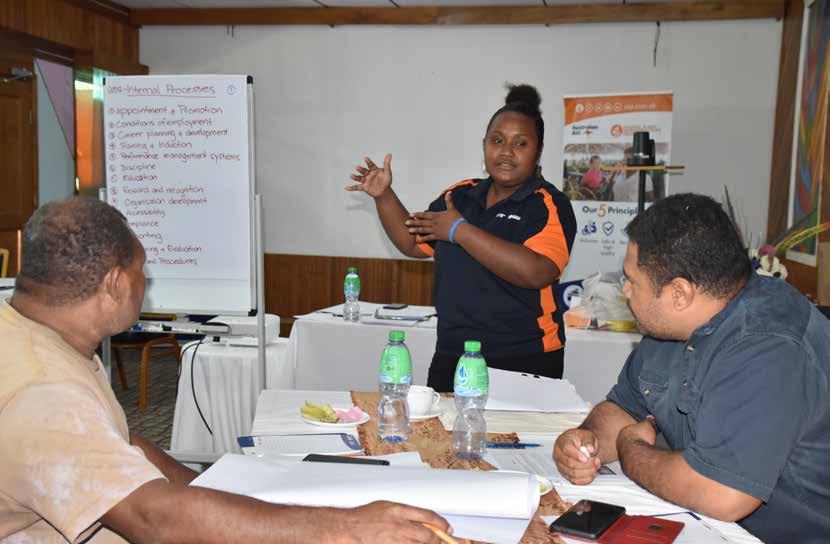
‘Local participation is critical to the sustainability of infrastructure,’ said Ms Hong.

Australia is exploring creative ways for the local workforce to employ more women. SIIP, together with Australia Pacific Training Coalition, are partnering with the Solomon Islands National University to support 19 women through a Certificate II in Construction course. This will be followed by training in solar system planning, installation and maintenance. The Green Construction Program was heavily subscribed to by women keen
to pave a new way for local content opportunities to be taken up by every part of society.
Now two months into the course, Priscilla hopes a formal qualification will lead to work.
‘I’ve always had an interest in carpentry work, and doing odd jobs around the house,’ she said.
‘We should do away with the notion that women be confined to housework and childbearing. We should believe in ourselves – if men can do it, so can we.’
Australia’s new International Development Policy has clear goals for its development activities across the world: all activities must be developed through a lens of maximizing local content, be inclusive of the needs of women and people with disabilities and be resilient to climate change and natural disasters.
As Solomon Islands’ largest development partner, Australia will continue to work across the entire infrastructure development ecosystem – partnering with government, private sector, multilateral partners, and, most importantly, local communities – to deliver a legacy of assets that drive social and economic outcomes, and a local infrastructure sector that delivers results. l
www.pacifictenders.com < 12
SIIP GEDSI Coordnator Ella Hou leading the Workforce Skills Series GEDSI Policy Training for local contractors.
Pacific Tenders Editorial Piece
Broadband towers funded by Chinese loan: here comes the internet
Most remote communities will never have a fixed landline telephone service. They won’t need it – mobile broadband is coming. In 2022, a Chinese consortium of Huawei and China Harbour Engineering Company was awarded a contract to build the Solomon Islands National Broadband Infrastructure Project (SINBIP). The idea is to build 161 towers across the country, connected to the existing Telekom network, to deliver 3G and 4G mobile data to 80% of the population. In many ways, it seems like a no-brainer to get mobile data to remote communities – it’s a simple equality measure. It has been in every national infrastructure plan since 2013. The project has been made viable by the connection of the undersea internet cable in 2020. Satellite broadband services were too unreliable to warrant the financial investment this requires. So now is the time.
A new state-owned enterprise will own, operate and maintain the assets. Internet access will enable online commercial transactions and e-services such as distance learning and telemedicine, as well as all the other benefits of connectivity. At the funding announcement in 2022, Prime Minister Sogavare was touting the benefits of people being able to watch to November 2023 Pacific Games without travelling to Honiara. With the sod turning occurring in August this year, that seems to be a missed opportunity. Regardless, the project will have benefits beyond 2023.
The project has been made technically possible by the connection of the undersea cable. The Coral Sea Cable System was funded by the Australian government and was completed in 2020. The system connects Honiara to the global internet, eliminating the need for satellite based internet, which was expensive and unreliable in adverse weather.
The internet paradox
The internet always sounds great in theory. What could possibly go wrong:
• 20% of the population will still have no access
• The cost of mobile data is already relatively high. The tariff model has not yet been released, but there is no reason to believe that it will be any cheaper than existing mobile costs – affordability in rural areas could be an issue
• Broadband is only useful if you have a smart phone, otherwise narrowband (2G) will do the job. Text messaging and mobile payments are already well established in the Solomon Islands economic ecosystem
• Online shopping will not be popular, as the delivery services typically don’t operate to Solomon Islands – the data will reveal this over time and advertisers may not pay to have their ads shown
• People in remote areas will finding the same challenge that everyone faces with internet use – accessing “free” content is done in exchange for their personal data and their time

It’s the economy, stupid
The cost of the project is CNY 448.9m ($US 60m). This is funded by an EXIM bank loan over 20 years, at a 1% interest rate. An independent review commissioned by the government confirmed the repayment period to be just over 11 years. The resilience of this forecast depends on the lease arrangements entered into between the owner and the carriers (Telekom and beMobile). If usage drops (due to any of the factors listed above), will the financial model be at risk?
Yet, the price elasticity of mobile data is high – people who come to rely on it for their work or leisure are prepared to pay higher prices to maintain access. With loan repayments on the line, this will be good news for the state-owned enterprise.
The literature seems to suggest that there is a small but measurable increase in a country’s Gross Domestic Product (GDP), when mobile broadband is introduced. The exact link is not clear, but if there is no notable increase in GDP, then it will create difficulties with the debt ceiling, which relies on GDP growth to enable more investment borrowing.
There is no evidence that any new mobile operators are looking to enter the Solomon Islands market. But this infrastructure expansion could be an incentive – to reach the majority of the population. Further competition would help keep prices affordable and would reduce the vulnerability of the lease payments, which are reliant on two carriers.
A broadband for contractors too
The construction of the towers is underway, so there’s limited opportunity to still secure a contract on the construction project. However, the outcome of the project will be greatly increased internet coverage.
This will increase the ease of doing business for many industries, including construction. Being able to access the internet remotely – to access files, standards, information, place orders, etc., would be a game changer for construction efficiency.
For a rural population who has never had a fixed landline, mobile broadband is a significant step forward.
> www.pacifictenders.com 13
PROUDLY PNG
YEARS ENGINEERING THE FUTURE 4
Who We Are
Did you Know?
We are the leading engineering and project management firm based in across South Pacific region.
Kramer Ausenco, a distinguished engineering, architectural, and project management firm, boasts a 45-year legacy of excellence. Recognizing the individuality of each project, we customize our solutions to match your distinct requirements, transforming your dreams into tangible realities. Our rich history of unwavering commitment and proficiency underscores our dedication to cocreating a brighter future alongside you. As our second office, Kramer Ausenco Solomon Islands has consistently led the charge in overcoming the distinctive engineering hurdles presented by the local terrain.
Our Services
• Architectural Design
• Professional Project Management
• Procurement + Planning
• Civil + Structural Engineering

• Building Services Engineering
• Quantity Surveying + Cost Planning
• Construction Management
• Feasibility Studies
Our Services
• Resources
• Energy + Renewables
• Government + Social
• Civil + Transport Infrastructure
• Commercial, Residential + Industrial
Why Partner With Us
• Expertise: Proven track record in delivering complex projects with efficiency and quality.

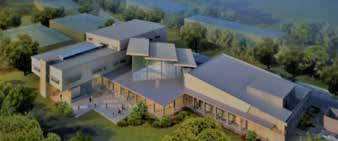
• Sustainability: Environmentally conscious solutions for positive community and planetary impact.

• Innovation: Leaders in technological advancements, driving infrastructure excellence.
• Compliance + Professionalism: Experts in local regulations, registered with institutions like IEPNG, IEAust, and IPENZ.
• Local Insight: Extensive knowledge for tailored solutions, addressing regional challenges effectively.
LEARN MORE AT WWW.KRAMERAUSENCO.COM



That’s a wrap: SIRAP2 project launched
NORO is best known for its tuna cannery and deep water port. It’s dusty in the dry and slippery in the wet. That’s all about to change for Noro’s several thousand residents in New Georgia province, Solomon Islands – SIRAP2 is coming to town, with upgraded and sealed roads.
The project was agreed by the government in April and confirmed by the World Bank in June. Solomon Islands borrowed $US 67.69m, with an accompanying grant ($US 21.52m) to build aviation infrastructure, roads and bridges around the islands.
What’s in it
How far does $US 89m go? It goes far enough to broadly address several economic recovery, national development and transport priorities for the government:
• Major aviation infrastructure including:
o Resurfacing of Henderson International Airport
o Upgrade and sealing of Lata domestic airport
o Construction of Munda international airport control tower
o Modern air navigation systems investments both in Honiara and Munda International Airports
o ADS-B and VSAT systems in Makira-Ulawa and Temotu Provinces

o Supporting regional airport maintenance
• Road and bridges projects:
o Seal Noro township roads (9.9km)
o Four bridges in Malaita - Kolofe 1 & 2 bridges on Malaita North Road; Su’u harbor and Bira village bridges on Malaita South Road.
Not all of these projects appear in the National Transport Plan (2017-2037), so the guiding principle for their selection is unclear. Notwithstanding, the projects follow a consistent theme – climate change.
Climate resilience
Admirably, many of the performance indicators for SIRAP2 are framed around climate adaptation and resilience. Yet the way these indicators will supposedly be achieved is by joining dissimilar dots. “Bridges with climate resilience and safety measures constructed and in use” to be achieved by “modular bridges, scour protection, separate footpaths.” While no-one would deny the construction efficiency of using modular bridges in some circumstances (see PT article “InQuik: bridging a gap in the market” in Issue 13), the marginal reduction in emissions or materials is negligible. Particularly for single span bridges such as these.
Scour protection is a standard requirement for bridges – what is often misunderstood is that scour protection is sacrificial, meaning that it is supposed to disappear in a flood. It slows the process of material loss around the supports (piles) such that the structure itself remains standing after the flood. The scour protection then needs to be repaired and replaced. Scour protection is not innovative – the standard (critical event) it is designed for determines its depth and mass and that is what matters.
Separate footpaths can be safer that walking on the road, if people use them. Yet on roads that carry less than 100 vehicles per day, the need for separate footpaths is questionable and may even prove counterproductive if the width of the footpath makes it harder to use than the road.
These discords perpetuate the lip service to climate change and resilience. Having a target like the above, is vague and therefore near-useless. Far better for a government-led strategic approach to resilience: every new bridge to be built to the same high standard, scour protection to the same critical flood event and a series of criteria around the need for separate footpaths. Using
www.pacifictenders.com < JULY - SEPTEMBER 2023 / ISSUE 14 16
DAVID SPRING PT COLUMNIST Sydney, Australia
the same modular bridge types would enable the Ministry of Infrastructure (MID) to invest in and develop an inventory and expertise in bridge maintenance and replacement, through their contractor network.
National contractors

That network will benefit from SIRAP2, regardless of MID’s strategy on design criteria. MID and the Ministry of Communication and Aviation (MCA) are the implementing agencies for the project. Happily, those ministries have worked with the World Bank to sequester some projects for the local contracting market. Most of the contracts are planned as being open to international contractors (which doesn’t preclude national contractors) but some contracts will be let for National firms only. These are:
• Seal Noro township roads (9.9km)
• Perimeter airport fence
• Malaita bridges
Some national individual consultants will also be procured. Surprisingly, the four bridges in Malaita are grouped into one single contract, for an estimated value of $US 8m. There are a limited number of national firms who could deliver the complexity of the bridge works, manage the logistics of construction at such remote distances from Auki, and be sufficiently financially liquid to manage the cashflow. Opportunity awaits.
The roadworks in Noro are separated into three separate contracts. This is most likely to enable small firms to bid for them – two sealing contracts and one rehab/repair contract. This is not the most ‘efficient’ way to procure the works, but reflects
the importance of supplying the local industry with a pipeline of work.
The cannery and the residents will appreciate SIRAP2’s efforts to upgrade their roads. With the Port Upgrade soon to start (Solomon Islands Infrastructure Program), Noro will reap the economic benefits of these investments for years to come. l
INFRASTRUCTURE DEVELOPMENT / INDUSTRY
Admirably, many of the performance indicators for SIRAP2 are framed around climate adaptation and resilience. Yet the way these indicators will supposedly be achieved is by joining dissimilar dots. “Bridges with climate resilience and safety measures constructed and in use” to be achieved by “modular bridges, scour protection, separate footpaths."
PNG NAC IMPROVING AIRPORTS WITH DONOR SUPPORT
By JASE SOM
Port Moresby, PNG
Airports infrastructure upgrade, redevelopment, safety and new works, has been the focus of Papua New Guinea’s National Airport Corporation (NAC) amid rising demands for air travel both domestic and international.
Degrading facilities and concerns of safety have also been on the radar as the NAC works on stamping out the issues that have plagued it for decades – a lack of rehabilitation, upkeep of facilities, new works and no upgrades due mostly to funding constraints.
But thanks to NAC’s focus on addressing these challenges and improving air transportation in PNG, and the generous support of various donors over the years, these challenges are being addressed. Recent support has come from the Asian Development Bank who funded the works on the Tari airport new terminal building and the Japanese International Cooperation Agency (JICA) who is upgrading the Nadzab domestic airport to an international port, at a cost of K750 million through a Japanese Overseas Development Assistance concessional loan and a PNG Government budgetary allocation.
NAC in appreciation, acknowledged the support and cooperation from the National Government, the Hela and Morobe Provincial Administrations, the ADB and the contractor who completed the Tari works, and the Japanese International Cooperation Agency (JICA) for funding the Nadzab airport redevelopment project.
TARI AIRPORT

In a statement about the Tari airport new terminal building, NAC
said ‘nestled amidst the stunning landscape of Hela, the Tari airport new terminal building marks a significant milestone in enhancing connectivity and accessibility as a gateway to a natural wonderland’.
The two ports are quite strategic in that the Tari Airport in Hela is home to the Hides Gas Project and the multi-billion kina PNG LNG project. It will ensure ease and convenience in travel and logistics for those traveling to Hela who can enjoy the upgraded facilities at the new terminal.
The PM in commenting said Hela is an important province for the country as its host’s significant national projects in Hides Gas and PNG LNG. He said ‘having an upgraded terminal and facilities means a much better connection and movement for people and cargo into and out of the province’.
NADZAB AIRPORT
On the outskirts of Lae, the new Nadzab International Airport will be an alternate port to the Port Moresby International Airport, addressing the rising needs of visits, anticipated rise in tourist’s numbers and can cater for the export of fresh agricultural produce to the Japanese and other international markets.
As a central port, Lae will greatly enhance connectivity and accessibility to the entire Momase, New Guinea Islands and the Highlands region via the Highlands Highway and its sea port. It is anticipated to boost trade of fresh agricultural and fisheries produce. Anything that is needed fresh to markets overseas, can be accommodated through the new Nadzab International Airport. The old airport terminal is being upgraded to facilitate anticipated increases in future cargo handling.
www.pacifictenders.com < JULY - SEPTEMBER 2023 / ISSUE 14 18
The new the Tari Airport in Hela. Photo Supplied
JICA President Professor Tanaka Akihiko visited PNG from April 17 – 20, this year, to inspect JICA’s cooperative projects and meet with the Prime Minister Hon. James Marape.

During his meeting, President Tanaka noted that PNG and Japan have been long-standing partners since the Second World War and that JICA looks forward to continuing a solid cooperative relationship. PM Marape responded in kind and expressed his appreciation for the quality of the projects that JICA has carried out so far, as well as his hope to continue to conduct ‘people-to-people and economic interactions to encourage the development of both nations.
Professor Tanaka along with Deputy PM Hon John Rosso, Civil Aviation Minister Hon. Walter Schnaubelt, visited the construction site of the Nadzab Airport Redevelopment Project and attended the nameplate unveiling ceremony.

Upon completion the new Nadzab International Airport will be renamed the Nadzab ‘Tomodachi’ International Airport (‘Tomodachi’ means friend in Japanese).
The specifications of the new Nadzab International Airport will see it become an alternate international airport for Port Moresby (Jackson) International Airport by accommodating wide body jet aircrafts. The works sees the length of the runway extended, widening of the runway to allow for the extended larger wide body jet aircraft, and the strengthening of the pavement to cater for the increased body weight of larger planes taxing along the runway.
Some of the goals of the Nadzab Airport Redevelopment Project by JICA include:
• Widening and/or strengthening of the exiting runway, taxi way and apron,
• Construction of new taxi ways and apron,
• Improvement of aeronautical ground lights,
• Construction of new passenger terminal building, administration building and fire station,
• Refurbishment of the existing passenger terminal building for future cargo handling,
• Construction of utilities, substation, pump houses and waste treatment facility
• Miscellaneous works &
• Procurement of Rescue and Fire Fighting Vehicles
NADZAB is an acronym that stands for Nothern Australian Defence
Zone Air Base (NADZAB). In about 1910 the Gabmatsung Lutheran Mission station was established at Nadzab, and established an airfield for use by small planes until the outbreak of the Pacific War.
NAC RECRUITMENT DRIVE
Meanwhile, NAC has been on a recruitment drive to fill in positions for the new airport facilities that have or will be soon completed. These includes the Kavieng Airport and the soon to be opened redeveloped Nadzab International Airport in Lae.
The NAC owns and operates 22 National Airports. l
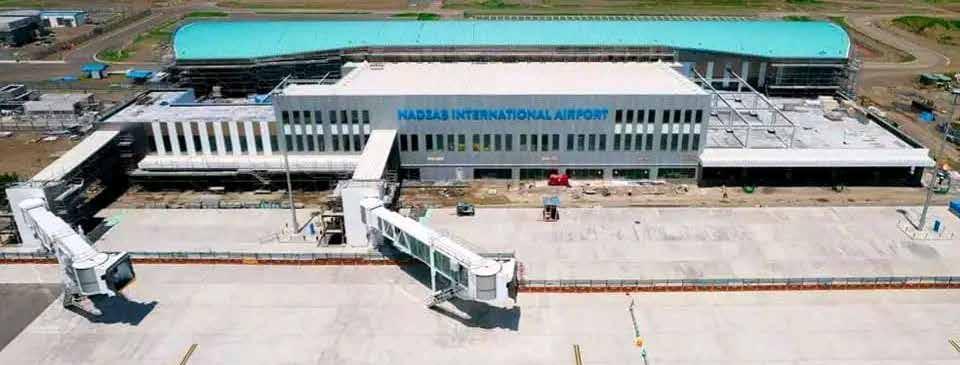 Transport and Civil Aviation Minister Hon. Walter Schnaubelt was given the honour by the Prime Minister Hon. James Marape to unveil the Plaque and cut the ribbon to officially open the new Tari Airport Terminal Building. Photo Supplied
The new NADZAB International Airport Building. Photo Supplied
Transport and Civil Aviation Minister Hon. Walter Schnaubelt was given the honour by the Prime Minister Hon. James Marape to unveil the Plaque and cut the ribbon to officially open the new Tari Airport Terminal Building. Photo Supplied
The new NADZAB International Airport Building. Photo Supplied
INFRASTRUCTURE DEVELOPMENT / INDUSTRY > www.pacifictenders.com 19
Minister for Transport and Civil Aviation Hon Walter Schnaubelt addressing the gathering. He was given the honour by the PM to unveil the Plaque and cut the ribbon to officially open the new Tari Airport Terminal Building. Photo Supplied

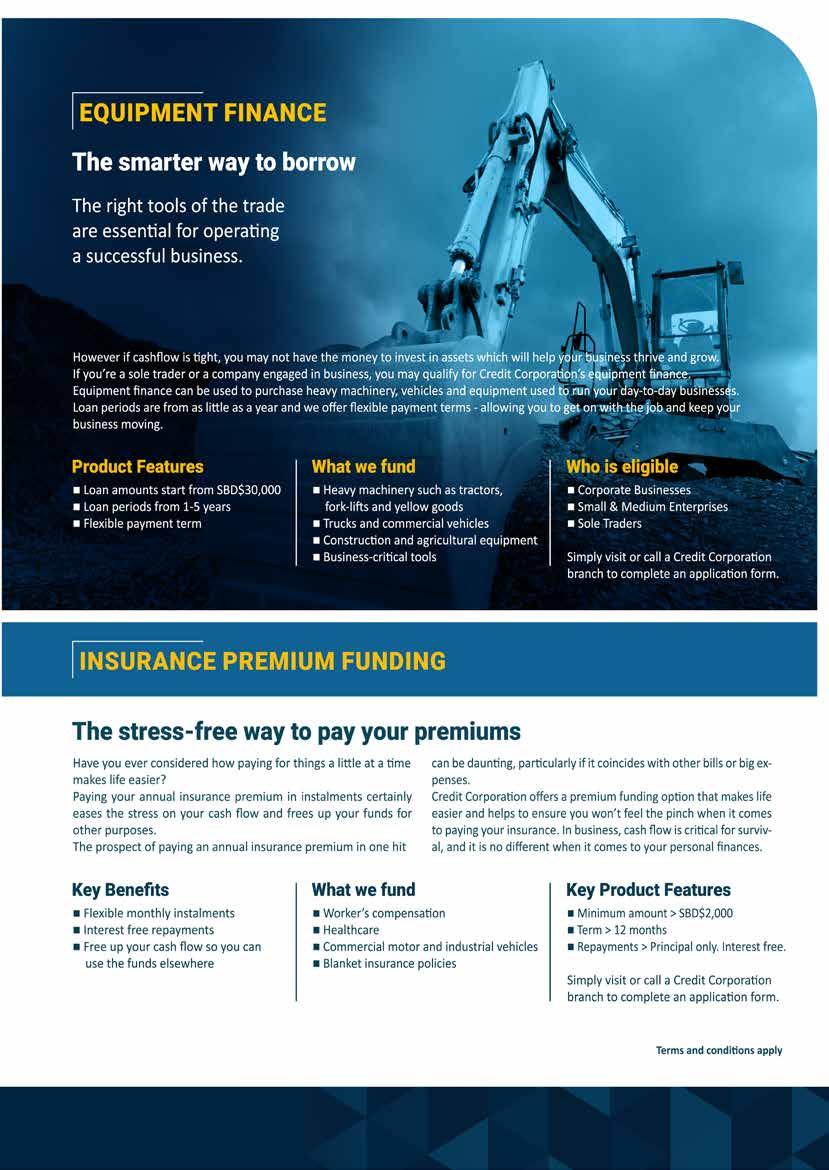
The Pacific Games 2023 Stadium China's Landmark Contribution to Pacific Infrastructure

THE PG2023 National Stadium, a significant symbol of collaboration between China and the Solomon Islands, stands as the largest infrastructure project China has supported within the Pacific island nations to date. Ambassador Li Ming, the Ambassador of the People's Republic of China to the Solomon Islands, proudly announced this during the official handover ceremony in Honiara on 18th August 2023.
Ambassador Ming confidently stated, "The PG2023 stadium is not just any venue; it is a world-class facility and a testament to the enduring friendship between China and the Solomon Islands. It embodies the pride and spirit of the Solomon Islander people."

Elaborating on its significance, Ambassador Ming highlighted that the national stadium represents the culmination of combined efforts between the two nations under the Belt and Road Initiative (BRI). Often referred to within China as 'One Road' or 'OBOR', the BRI is a comprehensive infrastructure development strategy inaugurated by the Chinese government in 2013.
Emphasizing its relevance, Ming expressed that the stadium not only elevates Solomon Islands' infrastructure but also resonates with the BRI's core spirit. "This iconic edifice not only serves as a hub for regional and national sports events but also promotes mutual understanding among nations. It fosters greater dialogue, enhanced communication, and cooperation, bridging civilizations and cultures."
He also underscored the stadium's representation of equality, respect, and the mutual cooperation that has flourished between China and the Solomon Islands. Expressing his gratitude, Ambassador Ming commended the Chinese contractors and Solomon Islands workforce behind the stadium's construction, noting, "From its very design inception, the unique traditions and culture of the Solomon Islands were considered and integrated, making this stadium a true melding of cultural exchanges."
Looking forward, Ming envisioned the national stadium serving beyond just sporting events. "It will evolve into a multifaceted
www.pacifictenders.com < 22
PRC Ambassador H.E.Li Ming opening the new turf at the National Stadium by kicking a penalty as the crowd watches with excitment.
space, offering the people of Solomon Islands and the broader region a venue to exercise, unwind, entertain, and partake in cultural celebrations, fostering unity and shared experiences."
Highlighting the unifying power of sports, Ming noted its potential in bridging understanding between different nations and promoting peace and harmony. In alignment with this spirit, he reaffirmed China's unwavering support for the Solomon Islands as they gear up to host the 2023 Pacific Games.


A noteworthy feature of the stadium is its seating capacity – accommodating 10,000 spectators, it boasts the largest seating arrangement for a national stadium in the region. Its seats are adorned in the blue, yellow, and green hues of the Solomon Islands' national flag. China's support also extends to the construction of the athlete's village, which will later serve as the dormitory for the Solomon Islands National University. This project is set to be handed over to the Solomon Islands' government and its people next month. l

NHA Chair Honoured 700 local workers that built the National Stadium Project
THE National Hosting Authority (NHA) Chair Dr Jimmie Rodgers has paid tribute to seven hundred skill workers from the Solomon Islands for their outstanding efforts and contribution in the development of the PG2023 National Stadium project.
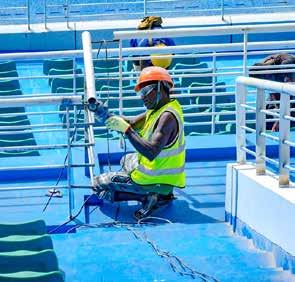
Dr Rodgers humbly honored the local workers in his welcome remarks at the official handing over ceremony of the national stadium project on Friday, 18 August 2023.
He highlighted that these facilities come from the hands of the 700 islanders who worked with the 300 people from China.
He informed the ceremony that these workers have faced the Covid 19 crisis, and they have suffered through the darkest days of the pandemic which many of them got Covid.
He described these islanders as champions during those periods because they have worked through the pandemic.
Dr Rodger thanked the 700 Solomon islanders and their families for their sacrifices.
He said if these local workers looked back, they would see the pride of what they had built to the development of the national stadium project.
The handing over of the national stadium projects marks one of the most successful infrastructure development projects in Honiara. l
PM Sogavare receives key to the New Stadium Complex from PRC Ambassador H.E.Li Ming.
> www.pacifictenders.com 23
A local worker with CCECC welding at the main stadium grand standing.
Another Games Facility Completed
Prime Minister Sogavare receives Iumi Water Sports Park from Australia
THE Australian government funded Iumi Water Sports Park has officially been handed over to Solomon Islands Prime Minister and Minister for the 2023 Pacific Games, Hon. Manasseh Damukana Sogavare, by the Australian High Commissioner to Solomon Islands His Excellency Rod Hilton on 5th September 2023.

The Iumi Water Sports Park is funded by the Australian government and cost SBD 4.3 million, as part of its support to the Solomon Islands Government for the 2023 Pacific Games. The open water facility will be used specifically for water sports likes kayaking, sailing and others.
Iumi Water Sports Park is only one component part of Australia’s AUD17 million support to the 2023 Pacific Games. All events which are hosted at this venue during the Games will be free to the public.
This significant infrastructure project provides enhanced facilities for our community and sports enthusiasts. It elevates Solomon Islands’ recreational offerings and improves overall accessibility for athletes during the Games.
The scope of work for this ambitious endeavor encompasses various aspects, each contributing to the overall transformation of the area. These include:

n Construction of Boat Storage Building: A pre-fabricated storage facility has been built to provide a secure and efficient space for boat owners to store outrigger/va’a canoes when not in use.
n Ablution Block: The construction of a modern ablution block ensures that visitors to the facility have access to clean and well-maintained restroom facilities.
n Fencing: A robust fencing system has been put in place to enhance security and delineate the area effectively.
n Installation of Security Lights: Security lighting has been strategically installed across the premises to ensure the safety of visitors during all hours.
n Installation of Borehole: A borehole water supply has been drilled and installed, ensuring a sustainable water source for the facility's operations.
n UXO Survey: The initial phase of the project involved a comprehensive Unexploded Ordnance (UXO) survey to ensure the safety of the construction process.
n Construction of Access Road: An access road has been built to provide easy and convenient entry to the site.
n Finishing Works: Ongoing finishing works are being carried out to meticulously refine and beautify the entire site. This substantial investment has been made possible through
a grant from the Australian Government, reflecting their commitment to fostering community development and recreational opportunities.
The success of this project would not have been possible without the collaboration and dedicated efforts of various contractors and sub-contractors. Each entity has played a crucial role in ensuring the high quality and timely execution of their designated tasks. The specific contractors and their contributions are as follows:
n LCJ Consultancy Company Ltd: Topographic Survey
n Azimuth Surveys Ltd: UXO Survey
n W.L Consultancy: Environmental Impact Assessment (EIA)
n Sustainable Resource Management Ltd: Road Works
n Mountol Enterprises and Motawa Enterprises: Construction of Boat Storage Facility and Ablution Block respectively
n Wan Build Construction: Fabrication of Office Spaces
n STM Construction: Installation of Security Lighting
n B2 Construction: Drilling and Installation of Borehole Water Supply
There are also plans for the Games Organizing Committee (GOC) to install a wheelchair ramp, further enhancing the accessibility and inclusivity of the site for all visitors.
As we reach the finishing line of this remarkable endeavor, we extend our gratitude to Australia, the Guadalcanal chiefs and landowners, the contractors, sub-contractors, and the entire community for their support and enthusiasm throughout this project. We anticipate that the enhanced facilities will contribute significantly to the well-being and enjoyment of all who engage with this space. l
www.pacifictenders.com < 24
PM Sogavare and Australian High Commissioner to Solomon Islands H.E Rod Hilton at the handing over ceremony.
Prime Minister Sogavare Delivers Upgraded Facilities to St. Nicholas College
ST. NICHOLAS Anglican College was buzzing with excitement last Friday as Prime Minister Manasseh Sogavare made a special visit to officiate the handover of the college's newly renovated facilities. In his capacity as the Minister of the Pacific Games 2023, PM Sogavare oversaw the unveiling of these upgraded amenities.
St. Nicholas Anglican College, one of the chosen Games Villages, will host athletes who will converge on Honiara before the official Games kickoff on November 19th. The extensive renovation efforts encompassed five buildings and three ablution blocks at the college.
The investment in upgrading education institutions, including St. Nicholas College, exceeded $50 million in Solomon Islands Dollars. This substantial financial support came from the Australian Government, exemplifying Australia's steadfast commitment to its partnership with Solomon Islands.
During his keynote address, PM Sogavare emphasized the importance of safeguarding these upgraded facilities, which will benefit students and teachers for years to come.
The Prime Minister also commended the principal, School Board and Education Authority of St. Nicholas College for their willingness to allow transformation of the school into one of the six Games Villages. He reiterated the government's deep appreciation to the Australian government for funding the enhancement of these vital facilities.
PM Sogavare's dedication to this initiative is evident as he continues to oversee the handovers of the remaining four games
villages in the coming weeks. With the involvement of 56 local companies in various projects across the six games villages, preparations are well underway to accommodate approximately 5,000 athletes during the 17th edition of the Pacific Games 2023. Meanwhile Australian High Commissioner to Solomon Islands H.E Rod Hilton exemplified the dedication by the Prime Minister Hon. Manasseh Sogavare through commitment and support to the 2023 Pacific Games preparations, to oversee the successful unveiling and handover of games villages.

High Commissioner Hilton reiterated Australia’s support to the country to host the best Pacific Games in Honiara. He also stressed that not only is the support intended for the games but, for the greater long-term legacy of these facilities for the purpose of further improving education in Solomon Islands.
The high Commission therefore called on students and the school administration to take good care of the newly refurbished facilities so that the next generation of students can also enjoy the same standard of facilities in the years ahead.
Also, in attendance at the were the Deputy Prime Minister Hon. Manasseh Maelanga, the Minister for Education Lanelle Tanangada, Senior Government Officials, Assistant Biship of the Diocese of Central Melanesia and staff and students of St. Nicholas Anglican college.
Following the handover of St. Nicholas College, the Prime Minister and the Australian High Commissioner are expected to unveil refurbishments at St. Joseph’s catholic School Tenaru, on the first week of October. l
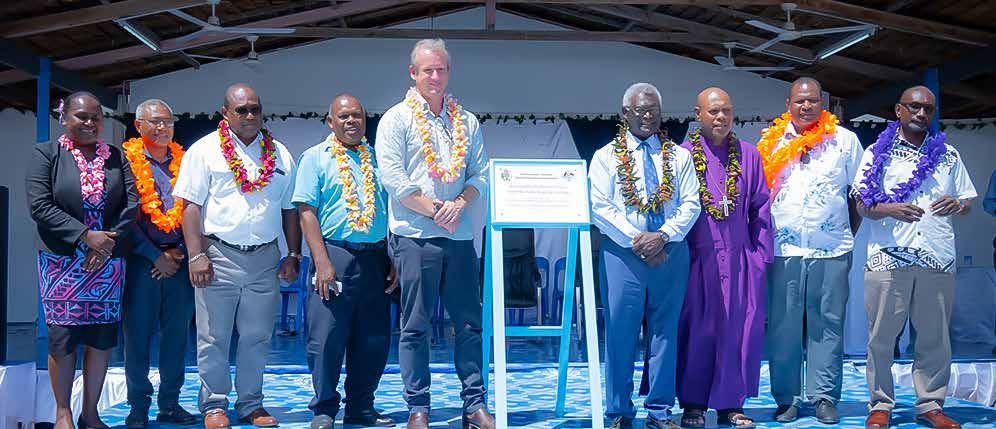
> www.pacifictenders.com 25
PM Sogavare and Australian High Commissioner to Solomon Islands H.E Rod Hilton (centre) with St. Nicholas Anglican College staff and reps. Also witnessing the ceremony were the Deputy Prime Minister Hon. Manasseh Maelanga (third from left) and the Minister for Education Mrs. Lanelle Tanagada (first from left).
Upgraded Facilities will leave a Legacy behind
THE handing over of the upgraded facilities of the Don Bosco Technical Institute that will be used to host athletes and officials during PG2023 Games will leave behind a legacy for the institute.
Prime Minister and Minister responsible for 2023 Pacific Games, Hon. Manasseh Sogavare made these remarks at the official handing over ceremony of Don Bosco Technical Institute on 8th September 2023, which was attended by guests, senior government officials and the Australian High Commissioner to Solomon Islands H.E. Rod Hilton.
He said the primary reason for the upgrade work to some of the facilities at Don Bosco Technical Institute is to ensure there is adequate rooms to cater for athletes and officials coming to the 2023 Pacific Games.
“This work will leave behind a legacy for the institute because the renovated facilities will serve our students for many years to come.”
The Prime Minister use the ceremony to thank the Archbishop of the Catholic Archdiocese of Honiara, the Rector of the Don Bosco Technical Institute, staff and students of the Technical Institute to be one of the six games villages for PG2023 Games.

He said their willingness to be part of the country’s efforts to host athletes from the 24 participating countries in the Pacific region, will ensure that our country will successfully host the 17th Pacific Games in November.
Sogavare convey his government’s sincere appreciation to the Australian High Commissioner to Solomon Islands for the assistance to help upgrade six of the country’s educational institutions for the 2023 Pacific Games and in legacy mode for students who will continue to use the facilities into the future.
“The work to help Solomon Islands prepare to host the 2023 pacific games has pulled us together despite our differences, our beliefs, as partners and from different countries and from different parts of Solomon Islands with one purpose is to uplift our nation and successfully deliver the 2023 pacific games together.”

Sogavare kindly accepted the upgraded facilities of the Don Bosco Technical Institute for use of sports men and women during PG2023 Games and beyond.
The Australian High Commissioner to Solomon Islands H.E Rod Hilton, said the Australian government is proud to support the Solomon Islands government efforts in ensuring the 2023 Pacific Games leaves a lasting legacy.
“The school refurbishments will continue beyond their initial purpose of housing athletes.”
He said these improvements to the school environment increase health and learning outcomes for students and the next cohort of skilled workers. l
www.pacifictenders.com < 26
PM Sogavare and Australian High Commissioner to Solomon Islands H.E Rod Hilton (centre) with Don Bosco staff and reps.

Honiara International Airport Improvements Completed in time for Pacific Games 2023
JAPANESE-FUNDED improvements to the Solomon Islands' primary airport in the capital city of Honiara have been successfully completed ahead of this year's Pacific Games. The Japanese International Cooperation Agency (JICA) allocated SBD 300 million (£30.1 million/$36.5 million/€34.4 million) to modernize Honiara International Airport. Japan's Ambassador to the Solomon Islands, Yoshiaki Miwa, formally presented these enhancements to the country's Prime Minister, Manasseh Sogavare in March.
These improvements encompassed the construction of a brandnew international departure terminal building, a thorough renovation of the existing structure, and the establishment of essential flood defenses. The newly erected building features a spacious departure area, duty-free shops, a business lounge area, and several dining facilities.
The project planning faced delays due to the COVID-19 pandemic in 2020, with construction commencing only in early 2021. In response to the pandemic, the Solomon Islands, along with other Pacific nations, implemented some of the world's strictest restrictions on international travel. These measures aimed to prevent the importation of cases. However, commercial flights to and from the country fully resumed in July of the previous year.
Prime Minister Sogavare expressed his gratitude to Japan during the presentation ceremony, emphasizing the positive impact of the upgrades on air traffic, as well as the potential for new investments and business opportunities. He was quoted as saying, "Ladies and gentlemen, let me thank the people of Japan and their Government, who are represented here today by the Ambassador, His Excellency Yoshiaki Miwa. I also extend my gratitude to JICA
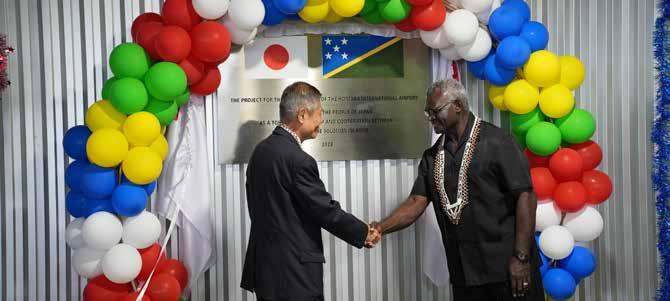
representatives who worked tirelessly to deliver this modern infrastructure. Please, Ambassador, convey our Government's sincere thanks to the Government and people of Japan for this invaluable assistance."
The transformation of the country's main international airport will elevate Henderson Airport to a key regional hub, making it one of the finest in the region. This renovation was completed just in time for the arrival of visitors to the Solomon Islands for the Pacific Games, originally scheduled for November 19 to December 2, but delayed by four months due to COVID-19.
Prime Minister Sogavare highlighted the significance of these improvements, particularly with the anticipation of 5,000 athletes and officials participating in the Pacific Games. He remarked, "I am sure that the capacity of this international departure will be put to the test then."
Solomon Airlines, which offers services to various domestic and international destinations, has stepped up as a presenting sponsor for the Solomon Islands 2023 Pacific Games. It serves locations within the country, as well as Brisbane in Australia, Fiji, Vanuatu, Papua New Guinea, and Kiribati.
Additionally, China has committed to assisting the Solomon Islands in constructing venues for the Pacific Games, in addition to the support provided by Japan for the airport project. Furthermore, the United States, in a bid to counter China's influence, has revealed plans to reopen its Embassy in Honiara this year, after closing it in 1993 as part of a post-Cold War diplomatic restructuring effort. l
www.pacifictenders.com < 28
Japan's Ambassador to the Solomon Islands, H.E Yoshiaki Miwa with PM Sogavare during the opening of the Honiara International Airport.
Solomon Islands Road and Aviation Project

2: Comprehensive Infrastructure Updates
The Solomon Islands Roads and Aviation Project (SIRAP) 2, has seen significant strides in recent months, reinforcing the nation's infrastructure and paving the way for enhanced connectivity and opportunities.

Honiara International Airport Gears Up for Major Improvements
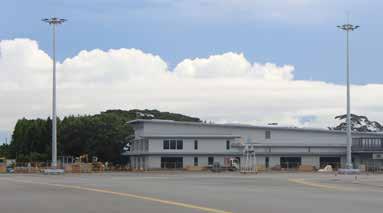
CRCEG has been diligently working on the upgrading of the Honiara International Airport runway since June 2023. Their commendable efforts have led to the recruitment of over 40 local staff. With the establishment of an expansive laydown area in progress, work includes ground leveling for a state-ofthe-art site office, meeting rooms, an asphalt plant, bitumen heating facility, drainage system, temporary dormitories for workers, and vital survey undertakings. Successful trial milling works on a significant portion of the eastern runway end safety area have also been achieved. Moses Virivolomo, Permanent Secretary of MCA, emphasized the strategic importance of these upgrades, ensuring that the Solomon Islands remains connected to the global world efficiently and safely.
Bridges in Malaita Set for Modern Reinvention
Three pivotal bridges in Malaita are undergoing a massive overhaul, with the pile driving phase successfully completed. The entrusted contractor, Reeves Envico, had initiated high strength concrete trials, gearing up for the substantial concrete works scheduled to start this month, September 2023. Despite slight delays due to unfavourable weather conditions in Malaita, optimism remains as the bridge works are poised to conclude by February 2024.
Munda International Airport: A Boost for Tourism
Munda International Airport marked a significant milestone with the completion of upgrades to its 2,100-meter-long runway on 25th August 2023. The enhancements promise to elevate the airport's functionality, offering resilience to the runway, taxiway, and apron. Moses Virivolomo, Permanent Secretary (PS) of MCA, spoke of the bright future ahead. The revamped Munda International Airport is expected to cater to larger aircraft, presenting boundless opportunities for the Western Province. The outlook appears bright, with the airport soon to offer international air links to prominent cities such as Brisbane, Port Vila, and Port Moresby. This will inevitably stimulate tourism, trade, and business ventures in the vicinity. The project was skilfully executed by the China Harbour Engineering Company Limited, contracted to SIRAP.
In summary, SIRAP2's ventures are creating a promising future for the Solomon Islands. As these vital projects near completion, the country is poised to reap the benefits of improved connectivity, economic growth, and strengthened international relations. l
Road relief works on Malaita roads.
An aerial view of the Munda International Airport.
Honiara International Airport.
> www.pacifictenders.com 29
Upcoming Air Traffic Control Towers in Honiara and Munda Boast Advanced Technology and Cultural Designs

HONIARA and Munda International Airports are set for an aviation upgrade as work begins on state-of-the-art Air Traffic Control Towers. The initiative is part of a comprehensive plan to elevate air travel safety and efficiency in the region.
The internationally recognized firm, Egis Asia Company Limited, has been entrusted with the task of developing the design and architectural plans for these sophisticated structures. The initial Concept Design has been finalized, paving the way for the final Design Report and the preparation of tender documents. Stakeholders anticipate the sealing of a construction contract by the dawn of 2024.
These contemporary Air Traffic Control Towers are not just about modern aesthetics. They are engineered to comply with both local and international building norms as well as aviation standards. Moreover, they incorporate resilience against the varied climatic impacts and volatile weather conditions, ensuring longevity and reliable operations.
Embracing the future does not mean sidelining the past. The
towers’ designs will showcase local influences, intertwining the Solomon Islands’ rich culture and heritage with modern architecture.
Equipped with cutting-edge technology, the towers will be instrumental in assuring that international aviation benchmarks are met consistently. This reinforces a commitment to facilitating air travel to Honiara and Munda that is not just safe but also efficient.
Moses Virivolomo, the Permanent Secretary of the Ministry of Communication and Aviation, expressed enthusiasm about this landmark project. “These new towers symbolize a bright future for air travel in our nation. It’s heartening to know that they will be reflective of our indigenous influences and the cultural spirit of the Solomon Islands.” He extended gratitude to the World Bank for their sustained backing via SIRAP2 and their relentless dedication to enhancing the safety and effectiveness of commutes within, and to, the Solomon Islands. l
www.pacifictenders.com < 30
Conclusion of Consultations on National Building Standards Bill and Building Code
PT MEDIA
The Ministry of Infrastructure Development (MID) has announced the successful conclusion of comprehensive consultations on the National Building Standards Bill and the National Building Code. The sessions, which took place on Friday, 28 July, in Honiara, come after years of meticulous work and collaboration.
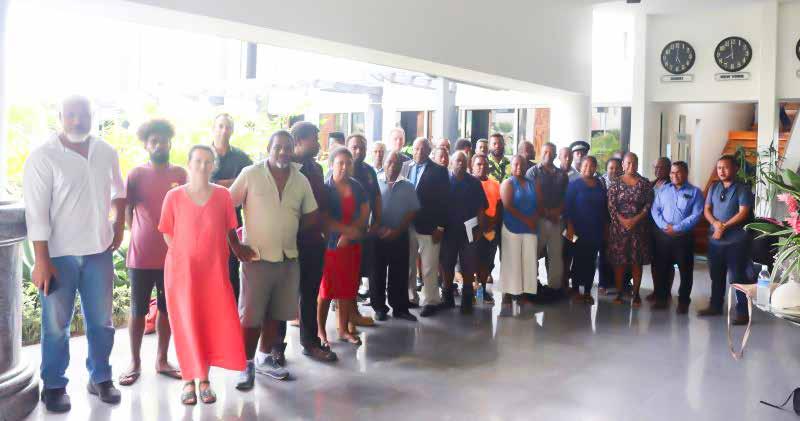
Over the years, MID has collaborated intensively with industry specialists, experts, and policymakers to hone the National Building Standards Bill. This bill, paired with the National Building Code, is set to introduce a comprehensive regulatory framework that will oversee building design, construction, and maintenance across the nation.
At the consultation, Permanent Secretary Stephen Maesiola spoke on behalf of the National Government and MID, emphasizing the urgent need to focus on the safety, resilience, and sustainability of our infrastructure. The proposed Bill offers the establishment of vital entities, including the National Advisory Committee and the position of Chief Building Inspector. This move ensures a rigorous focus on safety for all forms of construction, thereby safeguarding local residents. The National Building Code delves into detailed technical specifications essential for construction. It addresses several integral facets of construction, such as building design, materials, electrical frameworks, fire safety, and more. The core aim is to standardize construction protocols, guaranteeing superior structural quality and heightened
safety measures.
Elaborating on the broader vision behind the Bill, the Director of Architecture, Building, and Maintenance Services (ABMS), Mr. Phillip Baura, shed light on its environmental undertones. He stated, “This Bill embodies our commitment to environmental preservation, urging the incorporation of eco-friendly building materials and sustainable practices.” Baura also underscored the inclusive ethos of the new building standards, advocating for the accessibility of structures to everyone, including individuals with disabilities.
The Commissioner of Lands, a significant contributor to the project's present form, accentuated the coordinated effort involved. He commended the seamless collaboration between entities like the Honiara City Council, the National Planning & Development Board, and MID.
Reiterating the ongoing nature of the project, PS Maesiola remarked, “While we celebrate our achievements to date, we remain committed to refining the bill further. We continue to welcome input from the public, professionals, and stakeholders to ensure our Building Standards Bill and Building Code genuinely reflect our national interests.”
In conclusion, the Ministry expressed gratitude to former officers who played crucial roles in shaping the National Building Code. “Together, we pave the way for a brighter, safer, and flourishing future for our country,” concluded Mr. Maesiola. l
INFRASTRUCTURE DEVELOPMENT / INDUSTRY > www.pacifictenders.com 31
Participants from both Government and Private sector at the consulations in Honiara.
Kukum Highway Phase II: Set for October Handover
THE multimillion-dollar road upgrade project, generously funded by Japan, spanning from Kukum to Henderson, is poised for a formal handover to the Solomon Islands Government on October 5th, 2023. His Excellency Miwa Yoshiaki, the Japanese Ambassador to Solomon Islands, made this announcement during a recent press conference, underlining that the road is now technically complete and ready for its official unveiling.
Ambassador Miwa also disclosed that all activities associated with the project are slated to conclude by September 17th, 2023, setting the stage for the forthcoming handover ceremony. In a cordial invitation to local journalists, Excellency Miwa extended the opportunity for them to cover this significant event.
The Solomon Islands Government had previously signed a grant agreement totaling SBD$243 million with the Japanese government in June 2021. The objective was to enhance the main road from the Fishing Village to Honiara International Airport as part of the Kukum Highway Phase Two Project. Commencing construction early in 2022, the Kitano Construction Corporation has been diligently at work, crafting a 6.3-kilometer stretch of road.

The project encompasses the development of 4-lane roads leading to Lungga Bridge, followed by a 2-kilometer 2-lane road extending from Lungga Bridge to the Airport.
Dr. Jimmie Rodgers, Secretary to the Prime Minister and Chair of the Sol2023 National Hosting Authority, shared insights into the
project's timeline, noting, "By mid-October, all roadwork projects should be completed, marking the transfer of full responsibility to the Sol2023 Games Organizing Committee (GOC)." He emphasized that this transition would enable the GOC to conduct essential test runs, track routes, and manage timings across the road network.
Regarding the Highway from Honiara International Airport to the Fishing Village, Dr. Rogers mentioned, "By the end of September, it will be completed." He also acknowledged recent improvements on the Henderson-to-Honiara township highway. However, he clarified that work on the eastbound lane from the fishing village to the Ranadi roundabout is ongoing and will be sealed shortly. Post the Pacific Games 2023, certain sections will be revisited to complete sewage system installation.
On the matter of byways (minor feeder roads), he acknowledged financial issues but assured that tenders for these roads would be issued in September and October. This timeline aims to facilitate their completion by the end of October. Dr. Rogers also mentioned plans to introduce water taxis as an alternative mode of transportation and ease road congestion, awaiting confirmation from the Ministry of Infrastructure and Development (MID).
The timely completion of this project has been met with appreciation from the public, especially as the country prepares to host the Pacific Games in November this year. l
JULY - SEPTEMBER 2023 / ISSUE 14
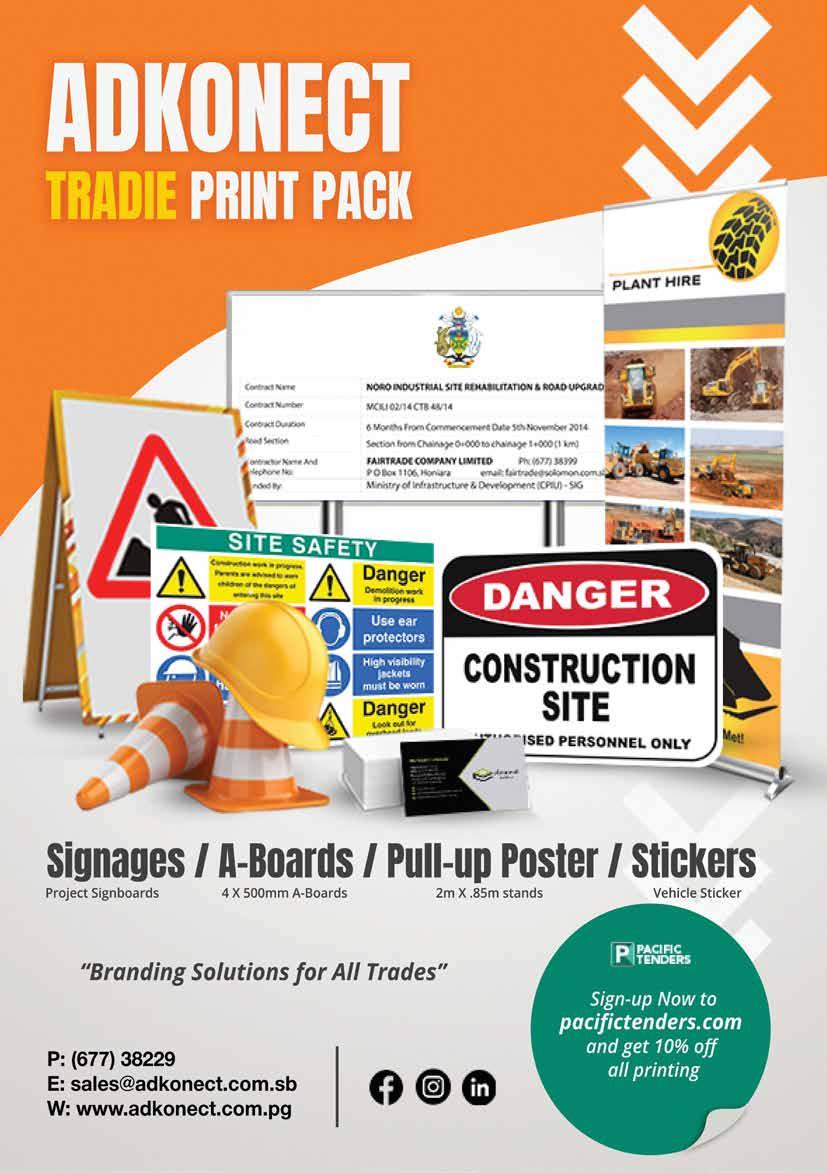


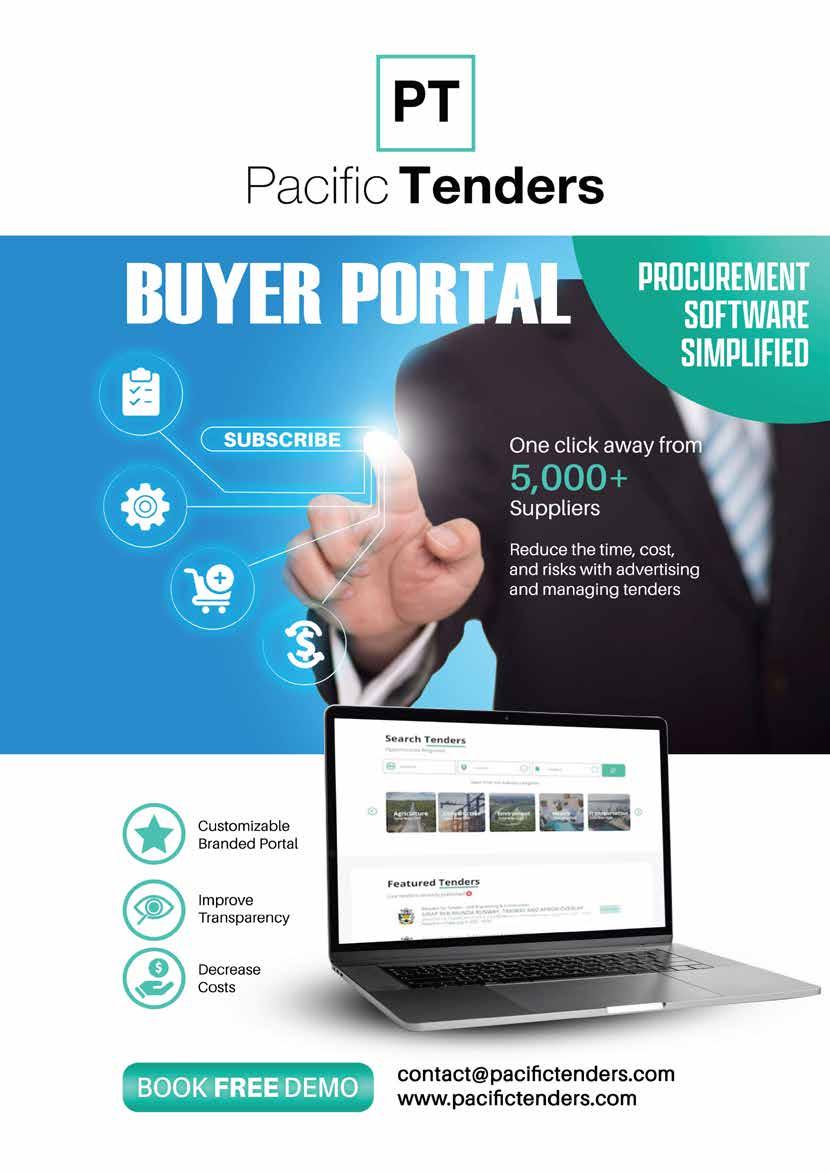





























 Transport and Civil Aviation Minister Hon. Walter Schnaubelt was given the honour by the Prime Minister Hon. James Marape to unveil the Plaque and cut the ribbon to officially open the new Tari Airport Terminal Building. Photo Supplied
The new NADZAB International Airport Building. Photo Supplied
Transport and Civil Aviation Minister Hon. Walter Schnaubelt was given the honour by the Prime Minister Hon. James Marape to unveil the Plaque and cut the ribbon to officially open the new Tari Airport Terminal Building. Photo Supplied
The new NADZAB International Airport Building. Photo Supplied
























